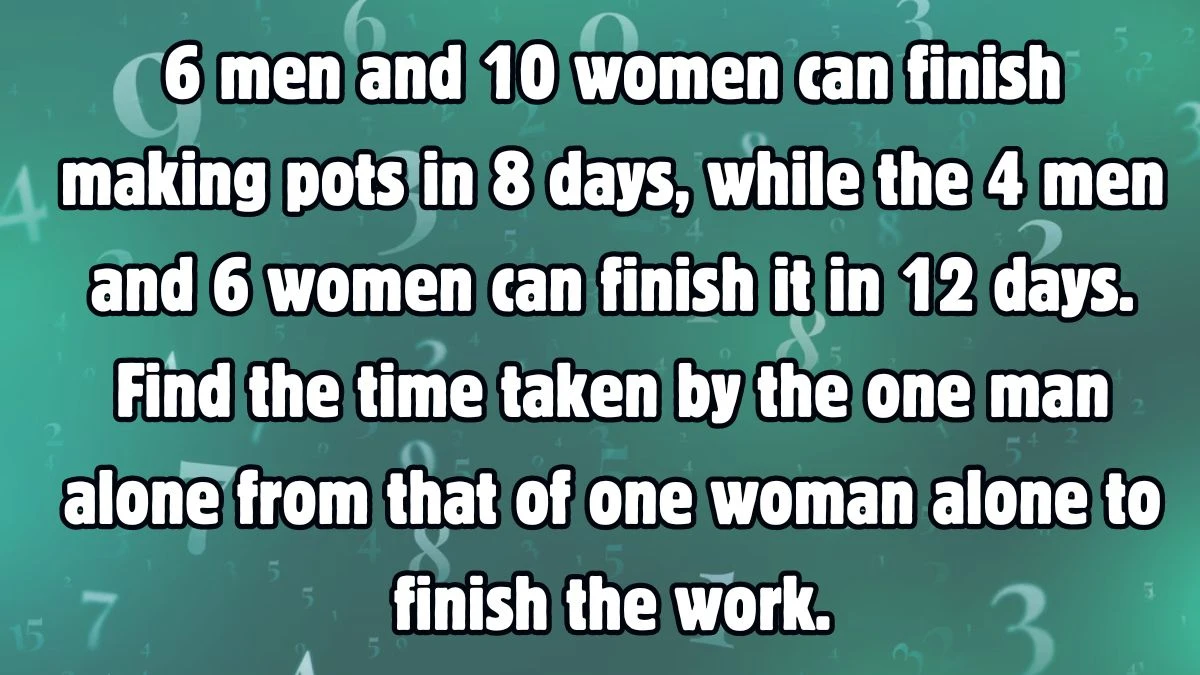6 men and 10 women can finish making pots in 8 days, while the 4 men and 6 women can finish it in 12 days. Find the time taken by the one man alone from that of one woman alone to finish the work.
by
Updated Jun 05, 2024

6 men and 10 women can finish making pots in 8 days, while the 4 men and 6 women can finish it in 12 days. Find the time taken by the one man alone from that of one woman alone to finish the work.
The problem states that 6 men and 10 women working together can finish making pots in 8 days, while 4 men and 6 women working together can finish the same task in 12 days. This sets up the efficiency and productivity rates of men and women working together on the task.
Setting Up Equations:
To solve for the time taken by one man alone compared to one woman alone to finish the work, we set up equations based on the work rates. Let the work done by one man in one day be represented as 1/x, and the work done by one woman in one day as 1/y.
First Equation:
The first equation comes from the information that 6 men and 10 women can finish the work in 8 days.
6/x+10/y=1/8, where 1/8 represents the work done in one day by the combined effort of the men and women.
Second Equation:
The second equation is derived from the scenario where 4 men and 6 women complete the task in 12 days, giving us
4/x+6/y=1/12, with 1/12 representing the daily work rate of this group.
Solving for Individual Rates:
By solving these equations simultaneously by considering 1/x = M and 1/y = W
M=1/48 , W= 0
Hence
x = 48
We find that the time taken by one man alone to finish the work is 48 days.
Analysis of Work Rates
When solving problems involving work done by different groups of people, we can set up equations based on the given data. These equations represent the combined work rate of each group and help us find individual work rates. For instance, if a certain number of men and women together can complete a task in a given time, we can express their combined work rate per day using fractions.
Similarly, if another group of men and women can finish the same task in a different time frame, we can set up another equation to represent their combined work rate per day. By solving these equations, we can determine the individual work rates of men and women, which in turn helps us find the time each group would take to complete the task alone. This process allows us to compare the time taken by different groups or individuals to complete the same task independently.
Linear Combination
- Linear combination refers to the process of combining multiple quantities using multiplication and addition.
- In the context of work rates, linear combination helps us understand how different individuals' work rates contribute to the overall work rate of a group.
- It involves multiplying each individual's work rate by a certain factor (which could be the number of individuals in the group) and then adding these products together.
- This method allows us to calculate the combined work rate of a group based on the work rates of its individual members.
- Linear combination is a fundamental concept in mathematics and is widely used in various fields, including solving systems of equations and analyzing data.




